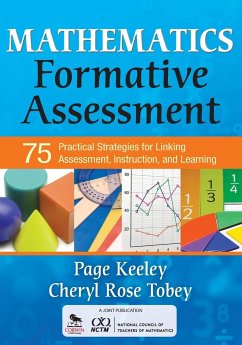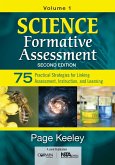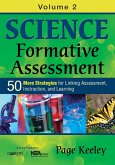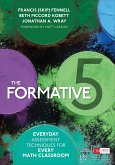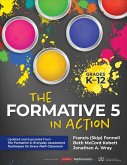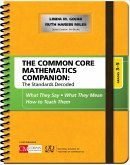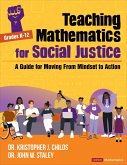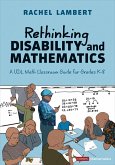Page D. Keeley, Cheryl Rose Tobey
Mathematics Formative Assessment, Volume 1
75 Practical Strategies for Linking Assessment, Instruction, and Learning
Page D. Keeley, Cheryl Rose Tobey
Mathematics Formative Assessment, Volume 1
75 Practical Strategies for Linking Assessment, Instruction, and Learning
- Broschiertes Buch
- Merkliste
- Auf die Merkliste
- Bewerten Bewerten
- Teilen
- Produkt teilen
- Produkterinnerung
- Produkterinnerung
This title follows Page Keeley's bestselling book on Science Formative Assessment. It identifies and describes practical techniques teachers can use to build a rich repertoire of formative assessment strategies for teaching math.
Andere Kunden interessierten sich auch für
![Science Formative Assessment, Volume 1 Science Formative Assessment, Volume 1]() Page D. KeeleyScience Formative Assessment, Volume 142,99 €
Page D. KeeleyScience Formative Assessment, Volume 142,99 €![Science Formative Assessment, Volume 2 Science Formative Assessment, Volume 2]() Page D. KeeleyScience Formative Assessment, Volume 248,99 €
Page D. KeeleyScience Formative Assessment, Volume 248,99 €![The Formative 5 The Formative 5]() Francis M. FennellThe Formative 526,99 €
Francis M. FennellThe Formative 526,99 €![The Formative 5 in Action, Grades K-12 The Formative 5 in Action, Grades K-12]() Francis M. FennellThe Formative 5 in Action, Grades K-1230,99 €
Francis M. FennellThe Formative 5 in Action, Grades K-1230,99 €![The Common Core Mathematics Companion: The Standards Decoded, Grades 3-5 The Common Core Mathematics Companion: The Standards Decoded, Grades 3-5]() Linda M. GojakThe Common Core Mathematics Companion: The Standards Decoded, Grades 3-530,99 €
Linda M. GojakThe Common Core Mathematics Companion: The Standards Decoded, Grades 3-530,99 €![Teaching Mathematics for Social Justice, Grades K-12 Teaching Mathematics for Social Justice, Grades K-12]() Kristopher J. ChildsTeaching Mathematics for Social Justice, Grades K-1230,99 €
Kristopher J. ChildsTeaching Mathematics for Social Justice, Grades K-1230,99 €![Rethinking Disability and Mathematics Rethinking Disability and Mathematics]() Rachel LambertRethinking Disability and Mathematics44,99 €
Rachel LambertRethinking Disability and Mathematics44,99 €-
-
-
This title follows Page Keeley's bestselling book on Science Formative Assessment. It identifies and describes practical techniques teachers can use to build a rich repertoire of formative assessment strategies for teaching math.
Hinweis: Dieser Artikel kann nur an eine deutsche Lieferadresse ausgeliefert werden.
Hinweis: Dieser Artikel kann nur an eine deutsche Lieferadresse ausgeliefert werden.
Produktdetails
- Produktdetails
- Corwin Mathematics Series
- Verlag: SAGE Publications Inc
- Seitenzahl: 256
- Erscheinungstermin: 15. September 2011
- Englisch
- Abmessung: 254mm x 178mm x 15mm
- Gewicht: 544g
- ISBN-13: 9781412968126
- ISBN-10: 1412968127
- Artikelnr.: 33444258
- Herstellerkennzeichnung
- Libri GmbH
- Europaallee 1
- 36244 Bad Hersfeld
- gpsr@libri.de
- Corwin Mathematics Series
- Verlag: SAGE Publications Inc
- Seitenzahl: 256
- Erscheinungstermin: 15. September 2011
- Englisch
- Abmessung: 254mm x 178mm x 15mm
- Gewicht: 544g
- ISBN-13: 9781412968126
- ISBN-10: 1412968127
- Artikelnr.: 33444258
- Herstellerkennzeichnung
- Libri GmbH
- Europaallee 1
- 36244 Bad Hersfeld
- gpsr@libri.de
Page is a prolific author of over twenty national best-selling and award-winning books, including twelve books in the Uncovering Student Ideas in Science series, four books in the first edition Curriculum Topic Study series, and four books in the Science and Mathematics Formative Assessment- Practical Strategies for Linking Assessment, Instruction, and Learning series. Several of her books have received prestigious awards in educational publishing. She has authored numerous journal articles and contributed to several book chapters. She is a frequent invited speaker at regional, national, and international conferences on the topic of formative assessment in science, understanding students' (and teachers') thinking, and teaching for conceptual understanding. Prior to leaving the classroom to work at the Maine Mathematics and Science Alliance in 1996, Page taught middle and high school science for 15 years. At that time she was an active teacher leader at the state and national level, serving two terms as President of the Maine Science Teachers Association and NSTA District II Director 1995-1998 and NSTA Executive Board member (prior to the Board and Council restructuring in 1997). She received the Presidential Award for Excellence in Secondary Science Teaching in 1992 and the Milken National Distinguished Educator Award in 1993. Since leaving the classroom in 1996, her work in leadership and professional development has been nationally recognized. In 2008 she was elected the 63rd President of the National Science Teachers Association (NSTA), the world¿s largest organization of K-12, university, and informal science educators. In 2009 she received the National Staff Development Council's (now Learning Forward) . In 2013 she received the Outstanding Leadership in Science Education award from the National Science Education Leadership Association (NSELA) and in 2018, The Distinguished Service to Science Education Award from NSTA. She has served as an adjunct instructor at the University of Maine, was a Cohort 1 Fellow in the National Academy for Science and Mathematics Education Leadership, was a science literacy leader for the AAAS/Project 2061 Professional Development Program, and served on several national advisory boards. She has a strong interest in global science education and has led science/STEM education delegations to South Africa (2009), China (2010), India (2012), Cuba (2014), Iceland (2017), Panama (2018), and Costa Rica (2019). Prior to entering the teaching profession, Page was a research assistant for immunogeneticist, Dr. Leonard Shultz, at the Jackson Laboratory of Mammalian Genetics in Bar Harbor, Maine. She received her B.S. in Life Sciences/pre-veterinary studies from the University of New Hampshire and her Masters degree in Science Education from the University of Maine. In her spare time she enjoys travel, reading, photography, fiber art, and dabbles in modernist cooking and culinary art. A Maine resident for almost 40 years, Page and her husband currently reside in Fort Myers, FL and Wickford, RI. Page can be contacted at pagekeeley@gmail.com or through her web site at www.uncoveringstudentideas.org
Preface
Acknowledgments
About the Authors
1. An Introduction to Formative Assessment Classroom Techniques (FACTs)
What Does a Formative Assessment?Centered Classroom Look Like?
Why Use FACTs?
How Does Research Support the Use of FACTs?
Classroom Environments That Support Formative Assessment
Connecting Teaching and Learning
Making the Shift to a Formative Assessment-Centered Classroom
2. Integrating FACTs With Instruction and Learning
Integrating Assessment and Instruction
Assessment That Promotes Thinking and Learning
Linking Assessment, Instruction, and Learning: The Mathematics Assessment,
Instruction, and Learning Cycle (MAIL Cycle)
Stages in the MAIL Cycle
Engagement and Readiness
Eliciting Prior Knowledge
Exploration and Discovery
Concept and Skill Development
Concept and Procedure Transfer
Self-Assessment and Reflection
Selecting and Using FACTs to Strengthen the Link Between Assessment,
Instruction, and Learning
3. Considerations for Selecting, Implementing and Using Data From FACTs
Selecting FACTs
Selecting FACTs to Match Learning Goals
FACTs and the Common Core Standards for Mathematics
Selecting FACTs to Match Teaching Goals
The Critical Importance of Classroom Context in Selecting FACTs
Planning to Use and Implement FACTs
Starting Off With Small Steps
Maintaining and Extending Implementation
Using Data From the FACTs
4. Get the FACTs! 75 Mathematics Formative Assessment Classroom Techniques
(FACTs)
#1. A & D Statements
#2. Agreement Circles
#3. Always, Sometimes, or Never True
#4. Card Sorts
#5. CCC: Collaborative Clued Corrections
#6. Comments-Only Marking
#7. Commit and Toss
#8. Concept Attainment Cards
#9. Concept Card Mapping
#10. Concept Cartoons
#11. Create the Problem
#12. Every Graph Tells a Story
#13. Example, Nonexample
#14. Fact-First Questioning
#15. Feedback to Feed-Forward
#16. Fist to Five
#17. Four Corners
#18. Frayer Model
#19. Friendly Talk Probes
#20. Give Me Five
#21. Hot Seat Questioning
#22. Human Scatter Graph
#23. Is It Fair?
#24. I Used to Think . . . But Now I Know . . .
#25. Justified List
#26. Justified True-or-False Statements
#27. K-W-L Variations
#28. Learning Goals Inventory (LGI)
#29. Look Back
#30. Matching Cards
#31. Mathematician¿s Ideas Comparison
#32. More A?More B Probes
#33. Muddiest Point
#34. No-Hands Questioning
#35. Odd One Out
#36. Opposing Views Probes
#37. Overgeneralization Probes
#38. Partner Speaks
#39. Pass the Problem
#40. P-E-O Probes (Predict, Explain, Observe)
#41. Peer-to-Peer Focused Feedback
#42. A Picture Tells a Thousand Words
#43. POMS: Point of Most Significance
#44. Popsicle Stick Questioning
#45. PVF: Paired Verbal Fluency
#46. Question Generating
#47. Response Cards
#48. Same A?Same B Probes
#49. Sequencing Cards
#50. Sticky Bars
#51. Strategy Harvest
#52. Strategy Probe
#53. Student Evaluation of Learning Gains
#54. Student Interviews
#55. Terminology Inventory Probe (TIP)
#56. Ten-Two
#57. Thinking Log
#58. Think-Alouds
#59. Think-Pair-Share
#60. Thought Experiments
#61. Three-Minute Pause
#62. 3-2-1
#63. Thumbs Up, Thumbs Down
#64. Traffic Light Cards
#65. Traffic Light Cups
#66. Traffic Light Dots
#67. Two-Minute Paper
#68. Two or Three Before Me
#69. Two Stars and a Wish
#70. Two Thirds Testing
#71. Volleyball, Not Ping-Pong!
#72. Wait Time Variations
#73. What Are You Doing and Why?
#74. Whiteboarding
#75. Word Sort
Appendix: Annotated Resources for Mathematics Formative Assessment
References
Index
Acknowledgments
About the Authors
1. An Introduction to Formative Assessment Classroom Techniques (FACTs)
What Does a Formative Assessment?Centered Classroom Look Like?
Why Use FACTs?
How Does Research Support the Use of FACTs?
Classroom Environments That Support Formative Assessment
Connecting Teaching and Learning
Making the Shift to a Formative Assessment-Centered Classroom
2. Integrating FACTs With Instruction and Learning
Integrating Assessment and Instruction
Assessment That Promotes Thinking and Learning
Linking Assessment, Instruction, and Learning: The Mathematics Assessment,
Instruction, and Learning Cycle (MAIL Cycle)
Stages in the MAIL Cycle
Engagement and Readiness
Eliciting Prior Knowledge
Exploration and Discovery
Concept and Skill Development
Concept and Procedure Transfer
Self-Assessment and Reflection
Selecting and Using FACTs to Strengthen the Link Between Assessment,
Instruction, and Learning
3. Considerations for Selecting, Implementing and Using Data From FACTs
Selecting FACTs
Selecting FACTs to Match Learning Goals
FACTs and the Common Core Standards for Mathematics
Selecting FACTs to Match Teaching Goals
The Critical Importance of Classroom Context in Selecting FACTs
Planning to Use and Implement FACTs
Starting Off With Small Steps
Maintaining and Extending Implementation
Using Data From the FACTs
4. Get the FACTs! 75 Mathematics Formative Assessment Classroom Techniques
(FACTs)
#1. A & D Statements
#2. Agreement Circles
#3. Always, Sometimes, or Never True
#4. Card Sorts
#5. CCC: Collaborative Clued Corrections
#6. Comments-Only Marking
#7. Commit and Toss
#8. Concept Attainment Cards
#9. Concept Card Mapping
#10. Concept Cartoons
#11. Create the Problem
#12. Every Graph Tells a Story
#13. Example, Nonexample
#14. Fact-First Questioning
#15. Feedback to Feed-Forward
#16. Fist to Five
#17. Four Corners
#18. Frayer Model
#19. Friendly Talk Probes
#20. Give Me Five
#21. Hot Seat Questioning
#22. Human Scatter Graph
#23. Is It Fair?
#24. I Used to Think . . . But Now I Know . . .
#25. Justified List
#26. Justified True-or-False Statements
#27. K-W-L Variations
#28. Learning Goals Inventory (LGI)
#29. Look Back
#30. Matching Cards
#31. Mathematician¿s Ideas Comparison
#32. More A?More B Probes
#33. Muddiest Point
#34. No-Hands Questioning
#35. Odd One Out
#36. Opposing Views Probes
#37. Overgeneralization Probes
#38. Partner Speaks
#39. Pass the Problem
#40. P-E-O Probes (Predict, Explain, Observe)
#41. Peer-to-Peer Focused Feedback
#42. A Picture Tells a Thousand Words
#43. POMS: Point of Most Significance
#44. Popsicle Stick Questioning
#45. PVF: Paired Verbal Fluency
#46. Question Generating
#47. Response Cards
#48. Same A?Same B Probes
#49. Sequencing Cards
#50. Sticky Bars
#51. Strategy Harvest
#52. Strategy Probe
#53. Student Evaluation of Learning Gains
#54. Student Interviews
#55. Terminology Inventory Probe (TIP)
#56. Ten-Two
#57. Thinking Log
#58. Think-Alouds
#59. Think-Pair-Share
#60. Thought Experiments
#61. Three-Minute Pause
#62. 3-2-1
#63. Thumbs Up, Thumbs Down
#64. Traffic Light Cards
#65. Traffic Light Cups
#66. Traffic Light Dots
#67. Two-Minute Paper
#68. Two or Three Before Me
#69. Two Stars and a Wish
#70. Two Thirds Testing
#71. Volleyball, Not Ping-Pong!
#72. Wait Time Variations
#73. What Are You Doing and Why?
#74. Whiteboarding
#75. Word Sort
Appendix: Annotated Resources for Mathematics Formative Assessment
References
Index
Preface
Acknowledgments
About the Authors
1. An Introduction to Formative Assessment Classroom Techniques (FACTs)
What Does a Formative Assessment?Centered Classroom Look Like?
Why Use FACTs?
How Does Research Support the Use of FACTs?
Classroom Environments That Support Formative Assessment
Connecting Teaching and Learning
Making the Shift to a Formative Assessment-Centered Classroom
2. Integrating FACTs With Instruction and Learning
Integrating Assessment and Instruction
Assessment That Promotes Thinking and Learning
Linking Assessment, Instruction, and Learning: The Mathematics Assessment,
Instruction, and Learning Cycle (MAIL Cycle)
Stages in the MAIL Cycle
Engagement and Readiness
Eliciting Prior Knowledge
Exploration and Discovery
Concept and Skill Development
Concept and Procedure Transfer
Self-Assessment and Reflection
Selecting and Using FACTs to Strengthen the Link Between Assessment,
Instruction, and Learning
3. Considerations for Selecting, Implementing and Using Data From FACTs
Selecting FACTs
Selecting FACTs to Match Learning Goals
FACTs and the Common Core Standards for Mathematics
Selecting FACTs to Match Teaching Goals
The Critical Importance of Classroom Context in Selecting FACTs
Planning to Use and Implement FACTs
Starting Off With Small Steps
Maintaining and Extending Implementation
Using Data From the FACTs
4. Get the FACTs! 75 Mathematics Formative Assessment Classroom Techniques
(FACTs)
#1. A & D Statements
#2. Agreement Circles
#3. Always, Sometimes, or Never True
#4. Card Sorts
#5. CCC: Collaborative Clued Corrections
#6. Comments-Only Marking
#7. Commit and Toss
#8. Concept Attainment Cards
#9. Concept Card Mapping
#10. Concept Cartoons
#11. Create the Problem
#12. Every Graph Tells a Story
#13. Example, Nonexample
#14. Fact-First Questioning
#15. Feedback to Feed-Forward
#16. Fist to Five
#17. Four Corners
#18. Frayer Model
#19. Friendly Talk Probes
#20. Give Me Five
#21. Hot Seat Questioning
#22. Human Scatter Graph
#23. Is It Fair?
#24. I Used to Think . . . But Now I Know . . .
#25. Justified List
#26. Justified True-or-False Statements
#27. K-W-L Variations
#28. Learning Goals Inventory (LGI)
#29. Look Back
#30. Matching Cards
#31. Mathematician¿s Ideas Comparison
#32. More A?More B Probes
#33. Muddiest Point
#34. No-Hands Questioning
#35. Odd One Out
#36. Opposing Views Probes
#37. Overgeneralization Probes
#38. Partner Speaks
#39. Pass the Problem
#40. P-E-O Probes (Predict, Explain, Observe)
#41. Peer-to-Peer Focused Feedback
#42. A Picture Tells a Thousand Words
#43. POMS: Point of Most Significance
#44. Popsicle Stick Questioning
#45. PVF: Paired Verbal Fluency
#46. Question Generating
#47. Response Cards
#48. Same A?Same B Probes
#49. Sequencing Cards
#50. Sticky Bars
#51. Strategy Harvest
#52. Strategy Probe
#53. Student Evaluation of Learning Gains
#54. Student Interviews
#55. Terminology Inventory Probe (TIP)
#56. Ten-Two
#57. Thinking Log
#58. Think-Alouds
#59. Think-Pair-Share
#60. Thought Experiments
#61. Three-Minute Pause
#62. 3-2-1
#63. Thumbs Up, Thumbs Down
#64. Traffic Light Cards
#65. Traffic Light Cups
#66. Traffic Light Dots
#67. Two-Minute Paper
#68. Two or Three Before Me
#69. Two Stars and a Wish
#70. Two Thirds Testing
#71. Volleyball, Not Ping-Pong!
#72. Wait Time Variations
#73. What Are You Doing and Why?
#74. Whiteboarding
#75. Word Sort
Appendix: Annotated Resources for Mathematics Formative Assessment
References
Index
Acknowledgments
About the Authors
1. An Introduction to Formative Assessment Classroom Techniques (FACTs)
What Does a Formative Assessment?Centered Classroom Look Like?
Why Use FACTs?
How Does Research Support the Use of FACTs?
Classroom Environments That Support Formative Assessment
Connecting Teaching and Learning
Making the Shift to a Formative Assessment-Centered Classroom
2. Integrating FACTs With Instruction and Learning
Integrating Assessment and Instruction
Assessment That Promotes Thinking and Learning
Linking Assessment, Instruction, and Learning: The Mathematics Assessment,
Instruction, and Learning Cycle (MAIL Cycle)
Stages in the MAIL Cycle
Engagement and Readiness
Eliciting Prior Knowledge
Exploration and Discovery
Concept and Skill Development
Concept and Procedure Transfer
Self-Assessment and Reflection
Selecting and Using FACTs to Strengthen the Link Between Assessment,
Instruction, and Learning
3. Considerations for Selecting, Implementing and Using Data From FACTs
Selecting FACTs
Selecting FACTs to Match Learning Goals
FACTs and the Common Core Standards for Mathematics
Selecting FACTs to Match Teaching Goals
The Critical Importance of Classroom Context in Selecting FACTs
Planning to Use and Implement FACTs
Starting Off With Small Steps
Maintaining and Extending Implementation
Using Data From the FACTs
4. Get the FACTs! 75 Mathematics Formative Assessment Classroom Techniques
(FACTs)
#1. A & D Statements
#2. Agreement Circles
#3. Always, Sometimes, or Never True
#4. Card Sorts
#5. CCC: Collaborative Clued Corrections
#6. Comments-Only Marking
#7. Commit and Toss
#8. Concept Attainment Cards
#9. Concept Card Mapping
#10. Concept Cartoons
#11. Create the Problem
#12. Every Graph Tells a Story
#13. Example, Nonexample
#14. Fact-First Questioning
#15. Feedback to Feed-Forward
#16. Fist to Five
#17. Four Corners
#18. Frayer Model
#19. Friendly Talk Probes
#20. Give Me Five
#21. Hot Seat Questioning
#22. Human Scatter Graph
#23. Is It Fair?
#24. I Used to Think . . . But Now I Know . . .
#25. Justified List
#26. Justified True-or-False Statements
#27. K-W-L Variations
#28. Learning Goals Inventory (LGI)
#29. Look Back
#30. Matching Cards
#31. Mathematician¿s Ideas Comparison
#32. More A?More B Probes
#33. Muddiest Point
#34. No-Hands Questioning
#35. Odd One Out
#36. Opposing Views Probes
#37. Overgeneralization Probes
#38. Partner Speaks
#39. Pass the Problem
#40. P-E-O Probes (Predict, Explain, Observe)
#41. Peer-to-Peer Focused Feedback
#42. A Picture Tells a Thousand Words
#43. POMS: Point of Most Significance
#44. Popsicle Stick Questioning
#45. PVF: Paired Verbal Fluency
#46. Question Generating
#47. Response Cards
#48. Same A?Same B Probes
#49. Sequencing Cards
#50. Sticky Bars
#51. Strategy Harvest
#52. Strategy Probe
#53. Student Evaluation of Learning Gains
#54. Student Interviews
#55. Terminology Inventory Probe (TIP)
#56. Ten-Two
#57. Thinking Log
#58. Think-Alouds
#59. Think-Pair-Share
#60. Thought Experiments
#61. Three-Minute Pause
#62. 3-2-1
#63. Thumbs Up, Thumbs Down
#64. Traffic Light Cards
#65. Traffic Light Cups
#66. Traffic Light Dots
#67. Two-Minute Paper
#68. Two or Three Before Me
#69. Two Stars and a Wish
#70. Two Thirds Testing
#71. Volleyball, Not Ping-Pong!
#72. Wait Time Variations
#73. What Are You Doing and Why?
#74. Whiteboarding
#75. Word Sort
Appendix: Annotated Resources for Mathematics Formative Assessment
References
Index

